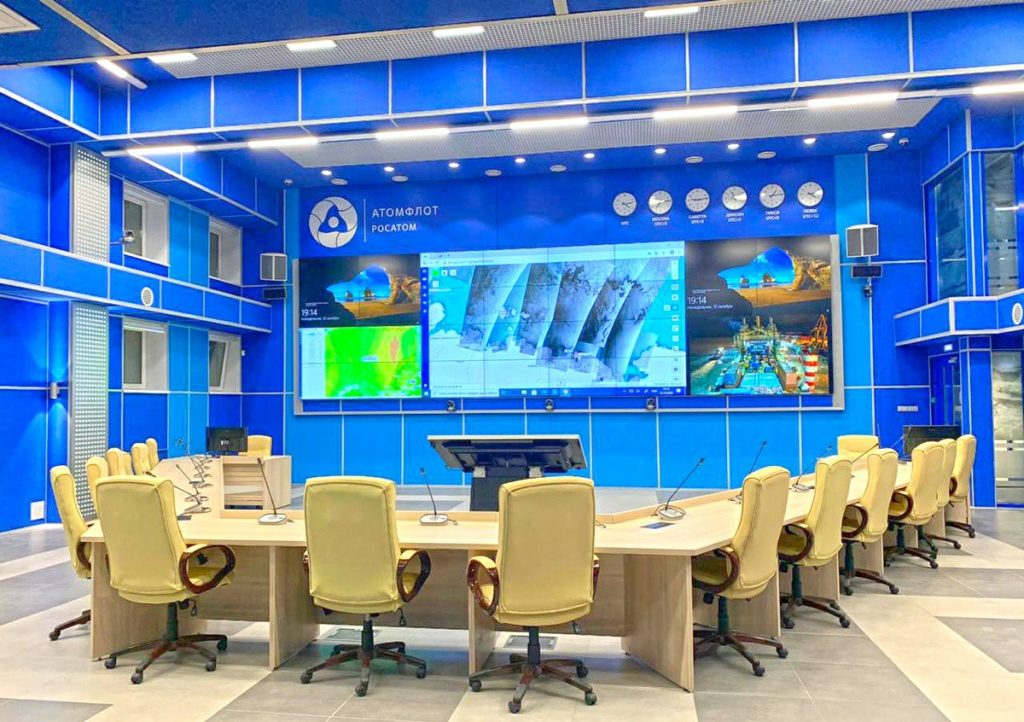
In Charge of Northern Sea Route
back to contentsThe Northern Sea Route Directorate stands apart among Rosatom’s divisions. Its task is to develop the high-latitude transit corridor between Europe and Asia. The new route is necessary to mitigate maritime traffic risks and offer freight carriers an alternative.
A short way to help
Redirecting some of the cargo traffic to the Northern Sea Route will increase reliability of the global trade flows, Rosatom believes. The need for a new maritime route, which would supplement the existing corridors, was made clear after several factors — quarantine restrictions in Chinese ports in February and an accident in the Suez Canal in March — came into play in the first half of 2021.
Speaking at the EXPO 2020 session entitled Supply Chain Resilience. Economic Corridor Via the NSR As a New Opportunity For Global Trade, Rosatom’s Deputy Director General for Corporate Development and International Business Kirill Komarov noted that the rate of change in maritime supply chains in the last two years was higher than over the past twenty years: “We have to understand the threats and possibilities this creates because sea logistics costs used to be considered an ordinary thing — if you have to transfer goods from one city to another you just need to pay for it. Now we begin managing risks, and tomorrow we will understand that the professional management of logistics and selection of correct solutions could affect the price significantly.”
Rosatom realizes the NSR is not a competitor or an alternative to Suez, but a transport corridor with its own niche, opportunities and advantages. Other market players are of the same opinion. “We see the northern transit corridor as being a viable alternative to the southern transit corridor in terms of servicing the Asia-Europe trade route. And as DP World, we play a major part in the southern trade route and globally through our ports in India, Africa, as well as Saudi Arabia. And we would very much like to be a dominant player together with our partner Rosatom in the northern transit corridor,” Raj Jit Singh Wallia, Deputy Chief Financial Officer at DP World, said when speaking at the session. Last year, this world leader in global supply chain solutions and the Russian nuclear corporation signed an agreement to pilot container freight traffic on the NSR.

“What the northern route needs to do is to target appropriate customers, target appropriate types of products to ensure that at the end of the day the value chains are taking the full advantage of the benefits this route obviously has,” said Paul Holthus, Founding President and CEO of the World Ocean Council.
The NSR grows in popularity with the global market players. In 2021, 86 ships, including 75 foreign-flag vessels, sailed that route to transport over 2 million tons of freight. In 2020, cargo transit on the NSR reached 1.3 million tons.
Access to the NSR becomes easier
In order to make the NSR more attractive to freight carriers, the NSR Directorate works to make it navigable all year round. The Directorate commissions the construction of new icebreakers, improves navigation and infrastructure, builds new terminals and organizes container traffic.
The NSR navigation window is expanding. For example, the Arctic LNG carrier Christophe de Margerie was the first to follow the Northern Sea Route eastwards in January–February 2021. Before that, liquefied natural gas had never been transported on the NSR so late in winter — its delivery to China usually took more than a month with gas carriers sailing through the Suez Canal and Strait of Malacca. The Northern Sea Route is almost a third faster so the decision was made to give it a try. No icebreaker escort was needed when Christophe de Margerie sailed eastwards. When traveling back, the LNG carrier was escorted by the 50 Let Pobedy icebreaker. Both voyages were successful.
In the winter-spring navigation of 2021–2022, the nuclear fleet is gaining more operating experience in the eastern section of the Northern Sea Route. In mid-December of 2021, Arktika, the lead Project 22220 nuclear icebreaker, escorted a ship convoy to Pevek (Chukotka). In January and February, Arktika continued its work in the eastern section of the NSR, escorting vessels from Russia’s Arctic ports to the Pacific Ocean and back. The navigation in the eastern NSR section used to finish in November. The year-round navigation on the NSR is expected to begin by 2030s.
In late January, Sibir (Siberia), first serial icebreaker of the Project 22220 design, joined the nuclear icebreaker fleet. Right after hoisting the colors, she set off on her first commercial voyage to the Yenisei Gulf and returned as soon as early February.
Rosatom will receive another three Project 22220 icebreakers in the next four years. Ural will be put into operation by the end of this year to be followed by Yakutia in 2024 and Chukotka in 2026. All the icebreakers are built at the Baltic Shipyard; the work is fully on track. Another icebreaker, Rossiya, is under construction at the Zvezda Shipyard. This one is built to Project 15010 (Lider-class) design and will be commissioned in 2027.
The NSR Directorate conducts offshore surveys along the Northern Sea Route to increase the number of recommended waterways. Last year, it completed a bathymetric survey covering 41,500 square kilometers and installed buoys with automatic identification systems. The Directorate is also developing a single platform for NSR digital services. The platform will integrate digital systems and databases to ensure navigation safety and provide dispatching services on the Northern Sea Route.

New terminal will be built to enable container traffic. Andrey Severilov, Chairman of the Board at Russia’s largest private logistics company FESCO, said at EXPO in Dubai that the container terminal agreed with Rosatom would be ready by 2025. The terminal will include a berth and a transshipment yard for intermodal containers at the commercial port of Vladivostok. Necessary permits have been obtained; site surveys and engineering design are underway. As for the western end of the NSR, a logistics hub is planned to be built on the western coast of the Kola Gulf. “A new stage of international transit will begin in 2025 — the western endpoint of the corridor will be situated in the Murmansk Region, near Murmansk,” Rosatom’s special envoy Vladimir Panov said at a meeting with the Governor of Murmansk Region, Andrey Chibis.




